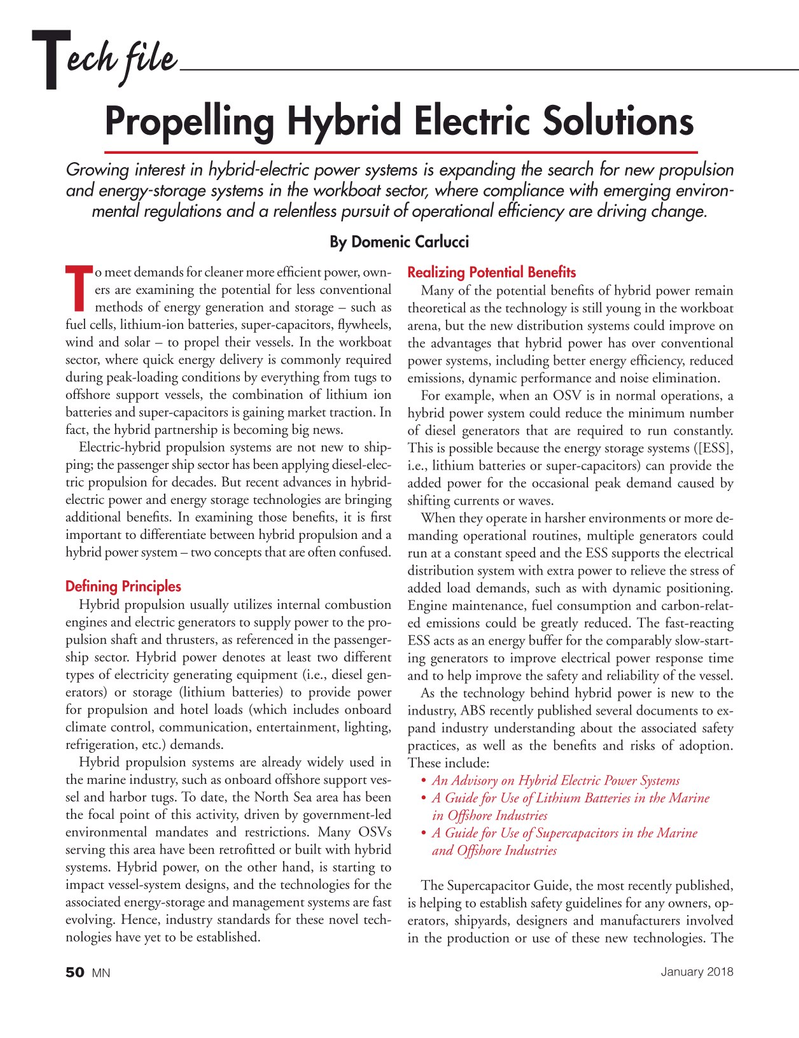
Page 50: of Marine News Magazine (January 2018)
Passenger Vessels & Ferries
Read this page in Pdf, Flash or Html5 edition of January 2018 Marine News Magazine
ech file
T
Propelling Hybrid Electric Solutions
Growing interest in hybrid-electric power systems is expanding the search for new propulsion and energy-storage systems in the workboat sector, where compliance with emerging environ- mental regulations and a relentless pursuit of operational ef? ciency are driving change.
By Domenic Carlucci o meet demands for cleaner more ef? cient power, own- Realizing Potential Bene? ts ers are examining the potential for less conventional Many of the potential bene? ts of hybrid power remain
T methods of energy generation and storage – such as theoretical as the technology is still young in the workboat fuel cells, lithium-ion batteries, super-capacitors, ? ywheels, arena, but the new distribution systems could improve on wind and solar – to propel their vessels. In the workboat the advantages that hybrid power has over conventional sector, where quick energy delivery is commonly required power systems, including better energy ef? ciency, reduced during peak-loading conditions by everything from tugs to emissions, dynamic performance and noise elimination.
offshore support vessels, the combination of lithium ion For example, when an OSV is in normal operations, a batteries and super-capacitors is gaining market traction. In hybrid power system could reduce the minimum number fact, the hybrid partnership is becoming big news. of diesel generators that are required to run constantly.
Electric-hybrid propulsion systems are not new to ship- This is possible because the energy storage systems ([ESS], ping; the passenger ship sector has been applying diesel-elec- i.e., lithium batteries or super-capacitors) can provide the tric propulsion for decades. But recent advances in hybrid- added power for the occasional peak demand caused by electric power and energy storage technologies are bringing shifting currents or waves.
additional bene? ts. In examining those bene? ts, it is ? rst When they operate in harsher environments or more de- important to differentiate between hybrid propulsion and a manding operational routines, multiple generators could hybrid power system – two concepts that are often confused. run at a constant speed and the ESS supports the electrical distribution system with extra power to relieve the stress of
De? ning Principles added load demands, such as with dynamic positioning.
Hybrid propulsion usually utilizes internal combustion Engine maintenance, fuel consumption and carbon-relat- engines and electric generators to supply power to the pro- ed emissions could be greatly reduced. The fast-reacting pulsion shaft and thrusters, as referenced in the passenger- ESS acts as an energy buffer for the comparably slow-start- ship sector. Hybrid power denotes at least two different ing generators to improve electrical power response time types of electricity generating equipment (i.e., diesel gen- and to help improve the safety and reliability of the vessel.
erators) or storage (lithium batteries) to provide power As the technology behind hybrid power is new to the for propulsion and hotel loads (which includes onboard industry, ABS recently published several documents to ex- climate control, communication, entertainment, lighting, pand industry understanding about the associated safety refrigeration, etc.) demands. practices, as well as the bene? ts and risks of adoption.
Hybrid propulsion systems are already widely used in These include: the marine industry, such as onboard offshore support ves- • An Advisory on Hybrid Electric Power Systems sel and harbor tugs. To date, the North Sea area has been • A Guide for Use of Lithium Batteries in the Marine the focal point of this activity, driven by government-led in Offshore Industries environmental mandates and restrictions. Many OSVs • A Guide for Use of Supercapacitors in the Marine serving this area have been retro? tted or built with hybrid and Offshore Industries systems. Hybrid power, on the other hand, is starting to impact vessel-system designs, and the technologies for the The Supercapacitor Guide, the most recently published, associated energy-storage and management systems are fast is helping to establish safety guidelines for any owners, op- evolving. Hence, industry standards for these novel tech- erators, shipyards, designers and manufacturers involved nologies have yet to be established. in the production or use of these new technologies. The
January 2018
MN 50

 49
49

 51
51
